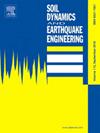Nonlinear damping baffle-isolated tuned liquid damper for vibration control
IF 4.2
2区 工程技术
Q1 ENGINEERING, GEOLOGICAL
引用次数: 0
Abstract
The traditional tuned liquid damper (TLD) has been demonstrated to mitigate structural dynamic responses through energy absorption and dissipation based on liquid sloshing. However, its effectiveness is limited by insufficient liquid mass utilization and diminishes under broadband excitation. To address these limitations, the nonlinear damping baffle-isolated tuned liquid damper (NDB-ITLD) is proposed as an alternative. A dual-performance-oriented design methodology for the NDB-ITLD has been developed, with a practical design curve for application. The NDB-ITLD is mounted externally on the primary structure with elastic isolators, incorporating the bottom-mounted vertical baffle within the liquid tank. A mechanical model and finite element simulation of the structure equipped with the NDB-ITLD are established, enabling a parametric investigation of the isolation layer and baffle parameters under white-noise excitation. The robustness of vibration mitigation is evaluated for structural response reduction under seismic excitation. The analysis results indicate that the NDB-ITLD effectively provides dual isolation and enhances inherent liquid damping due to the bottom-mounted vertical baffle. A broader vibration suppression frequency range and reduced displacement of the isolation layer are achieved, improving the structural response mitigation efficiency of the NDB-TLD. Additionally, the NDB-ITLD exhibits robust vibration control across diverse seismic intensities and types, attributed to its superior energy absorption and dissipation capabilities.
求助全文
约1分钟内获得全文
求助全文
来源期刊

Soil Dynamics and Earthquake Engineering
工程技术-地球科学综合
CiteScore
7.50
自引率
15.00%
发文量
446
审稿时长
8 months
期刊介绍:
The journal aims to encourage and enhance the role of mechanics and other disciplines as they relate to earthquake engineering by providing opportunities for the publication of the work of applied mathematicians, engineers and other applied scientists involved in solving problems closely related to the field of earthquake engineering and geotechnical earthquake engineering.
Emphasis is placed on new concepts and techniques, but case histories will also be published if they enhance the presentation and understanding of new technical concepts.
 求助内容:
求助内容: 应助结果提醒方式:
应助结果提醒方式:


